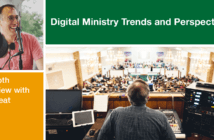As a new year begins, there will and should be a careful review of the past year. Perhaps there will be reports made to the church council or congregation on “how we did last year.” If statistical trends are shared, they probably show a mixture of increases and declines. Such is the ebb and flow of most congregations.
The economic model that sustains many congregations is that each year fewer people will give more. While that is a way to get through another year, it is hardly a solid foundation to sustain and expand the congregation’s mission.
For a majority of declining congregations, the good news in such reports often is that giving went up and per capita giving (whether figured on attendance, membership, or number of donors) went up. Isn’t this good news? In the short term, yes. But for the long term, it is a frightening trend.
As worship attendance has declined, especially since 2002, the saving grace for many churches has been that giving continued to increase. Thus, the economic model that sustains many congregations is that each year fewer people will give more. While that is a way to get through another year, it is hardly a solid foundation to sustain and expand the congregation’s mission.
Money Can Be Deceptive
It’s strange to think that people giving more money to the church might be an occasion for pause among congregations. In fact, a few years back a large denomination set out to identify vital congregations and then to see what factors might account for that vitality. The researchers were given a series of characteristics that that denomination’s leaders believed were signs of growing vitality. One was an increase in “annual giving per attendee.” Sounds too logical to not be the case.
Let’s look at United Methodist churches that grew and declined over a recent ten-year period.
- In churches where attendance grew by 50 or more over ten years, “annual giving per attendee” declined $285 after adjusting for inflation.
- In churches where attendance declined by 50 or more over ten years, “annual giving per attendee” increased $623 after adjusting for inflation.
The remarkable, even shocking, contrast of attendance trends with financial trends serves as a reminder that money is a lagging indicator. You see, money can make up for, and tend to obscure, many problems. Life can go on much as it did before, as long as funding is in place. What is new today is the realization that aging members with increased assets and generosity cannot substitute forever for the neglect of the basics on which all giving depends — changed lives and transformed communities.
The Solution is Simple but Slow
Why do growing churches have lower per capita giving? Notice that this does not mean they have less money. Indeed, they have more money because they have more people giving, but the average giving per attendee is less than before they grew. Here’s what happens:
- Growing churches reach new people, many of whom have not been attending church, at least in recent years. Since the unchurched are typically younger than regular church attenders, they have fewer financial assets.
- More importantly, these new people tend not to bring spiritual maturity, including the practice of regular giving, much less tithing.
- In fact, growing churches will sometimes have old timers say of newcomers, “They aren’t paying for themselves.” That may be true, at least for a time.
Growing churches always see positive financial gains as new people arrive, but they don’t count on large gifts or even giving that keeps up with added church expenses. Greater giving will come with time and discipleship growth, just as it happened for the most dedicated of current longtime members. To reach those outside the church means to reach those who may very well be younger, poorer, less educated, less likely to be married, and less spiritually grounded than current members. Don’t regret that reality; celebrate it.
While you give thanks every day for those faithful and generous members who made it possible for your church to make financial progress last year, remember that the greatest gift they are giving your church is some precious months and years to engage new people. These new people can immediately bring energy and service to your church and, with spiritual encouragement and growth, mature into generous disciples themselves who can help make possible faith for a next generation of believers.
Related Resources:
- Removing Obstacles to Giving by Lovett H. Weems, Jr.
- Overcoming the Fear of Talking About Money by Cathy Abbott
- Tell Your Stewardship Story by Margaret J. Marcuson






